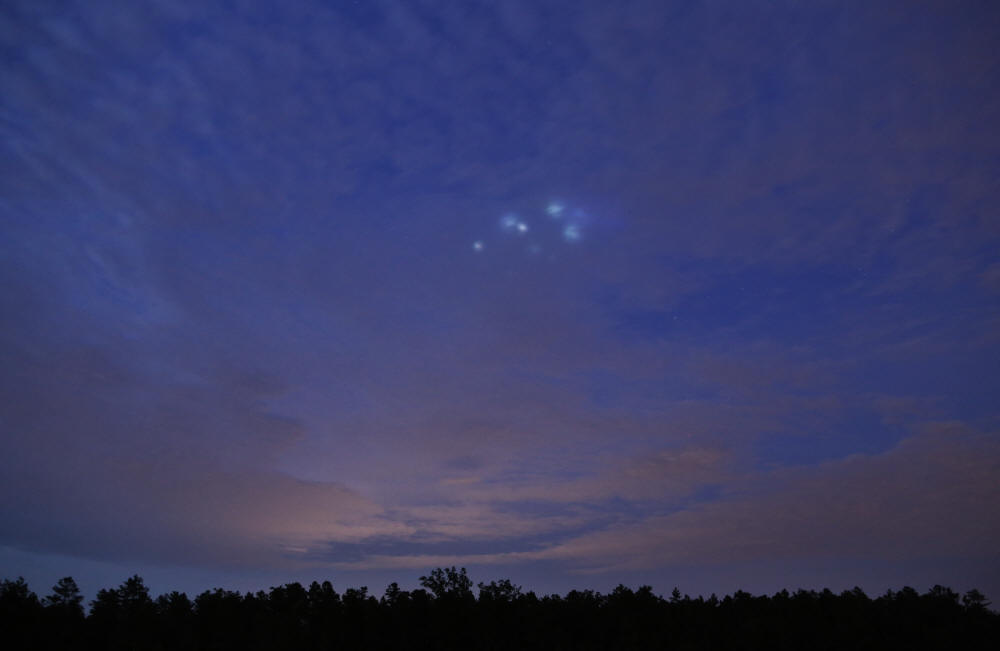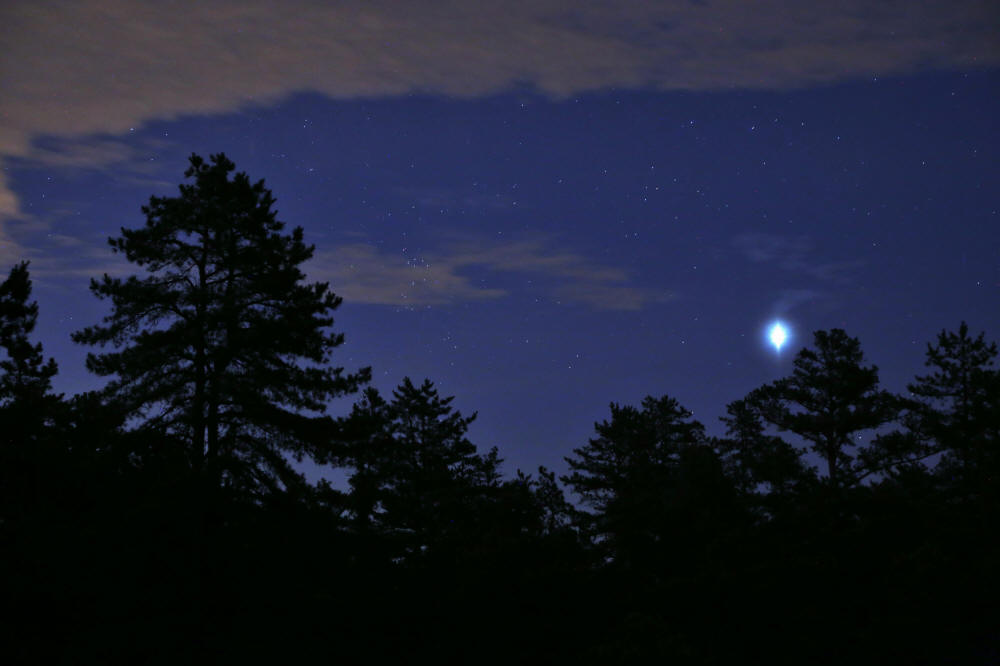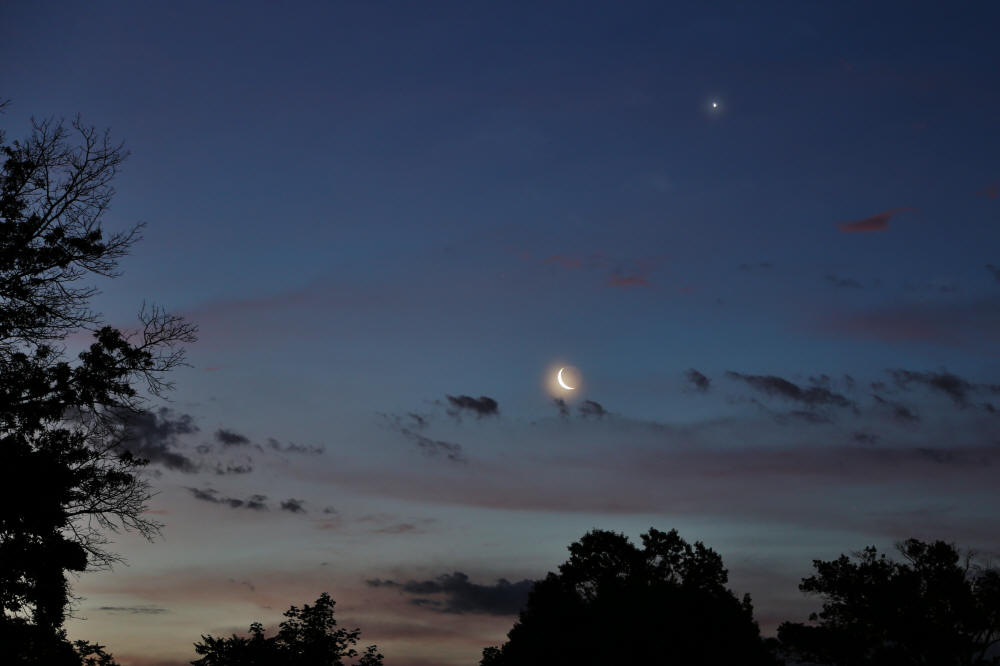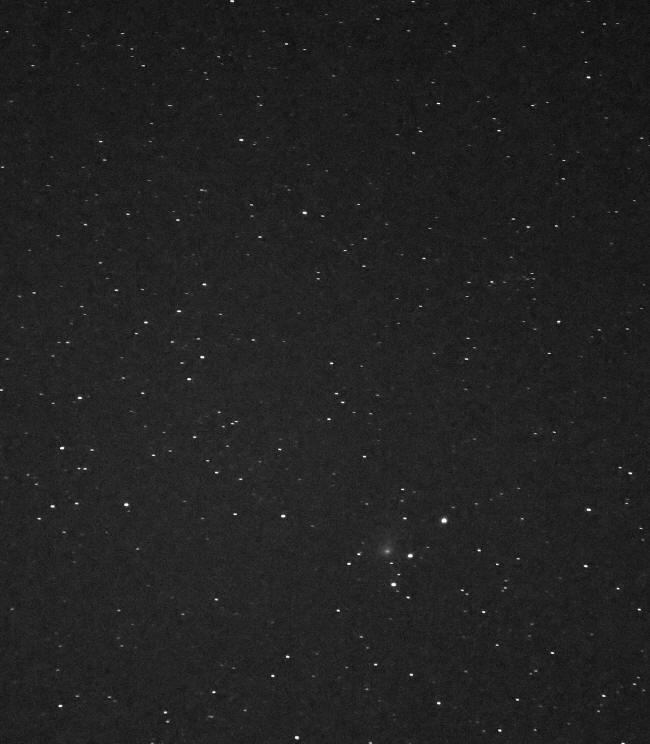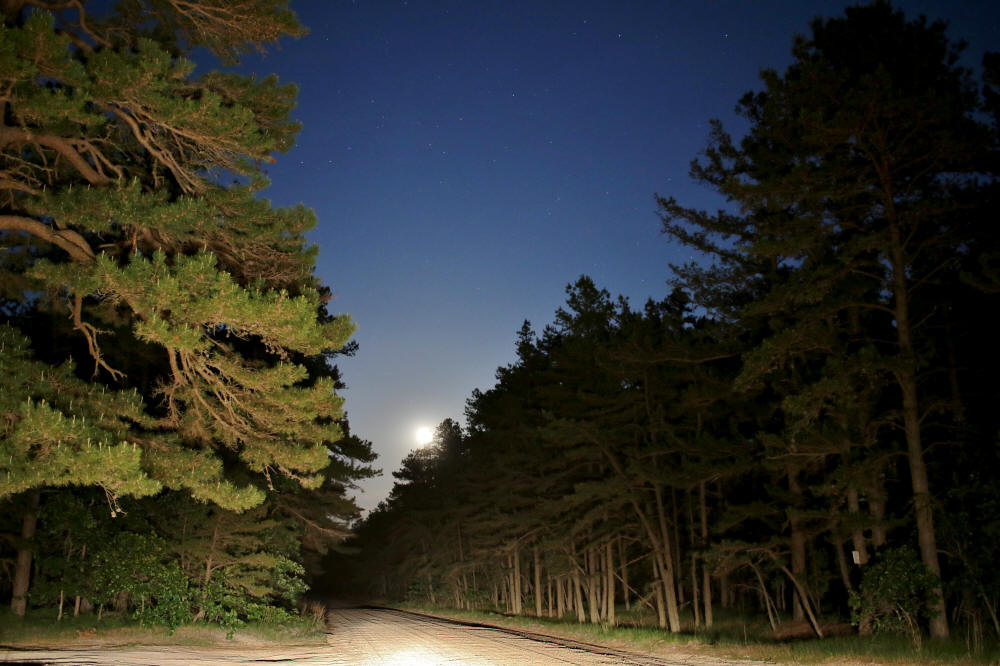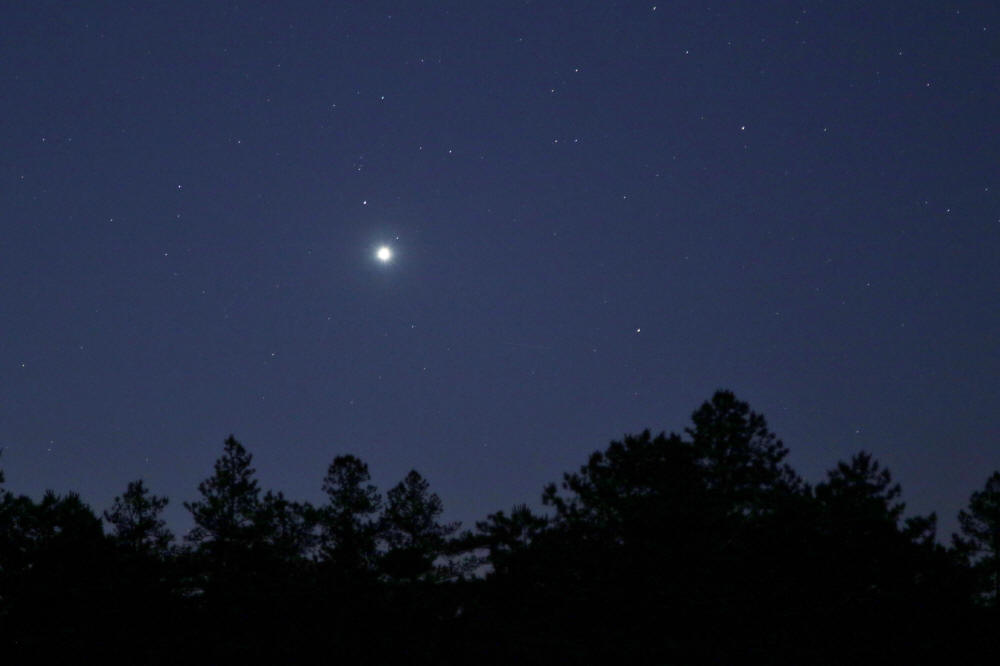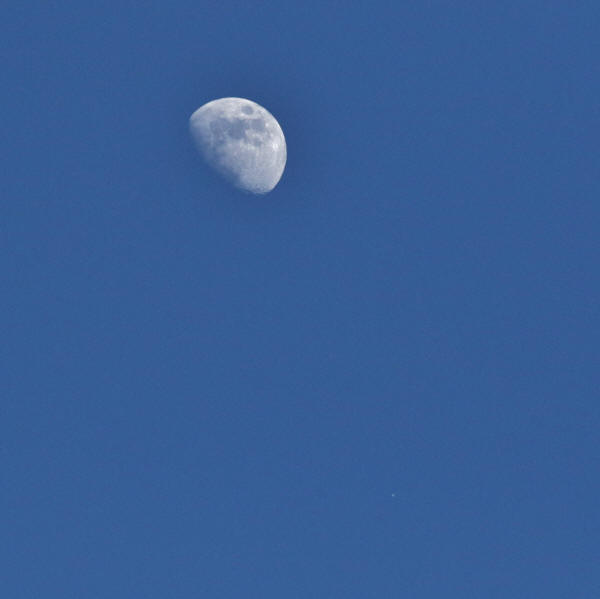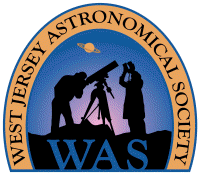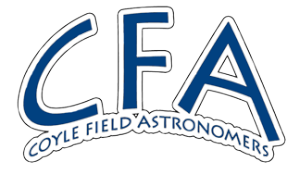Artificial Clouds from the Wallops Rocket Launch
June 29, 2017
On June 29, 2017, there was a sounding rocket launch from the NASA facility at Wallops Island, Virginia, to test a new system for dispersing artificial tracer clouds. The rocket launched at 4:25 am EDT, and from Carranza Field in Wharton State Forest, NJ (142 miles from the launch pad), the first cloud was spotted at 4:28 am. This image was captured at 4:30 am and shows a cluster of artificial clouds towards the south at about 35° altitude. They look "white" in the picture, and no particular color was noted visually through the heavy overcast (no stars were visible). This observer was surprised to see anything at all. Magnifying the original image, I was able to see a few stars between clouds, in particular, I was able to identify 36 and Eta Capricorni, which are 6° apart. Using them as a reference, the artificial cloud cluster measured about 8° wide along a mildly-sloped centerline.
Taken with a Canon 6D digital SLR camera (on a fixed tripod) and a Canon 24 to 105 mm f/4L zoom lens set to 24 mm focal length. Exposed 6 seconds at f/4, ISO 3200. Click here for all of the individual frames taken that showed some cloud formation. The glowing natural clouds just above the tree line are being illuminated by Atlantic City, NJ, 30 miles away towards the south-southeast.
Ray Maher of the South Jersey Astronomy Club also captured a nice series of artificial cloud images from farther south in New Jersey, evidently near the north shore of the Delaware Bay under clear skies. Click here to see them.
Venus and the Pleiades
June 29, 2017
On June 29, 2017, the brilliant (and greatly overexposed) planet Venus was near the Pleiades star cluster (Messier 45) in Taurus when this image of them was captured at 3:53 am EDT, 21 minutes after the start of astronomical twilight, from Carranza Field in Wharton State Forest, NJ. At the time, Venus was about 9½° altitude in the east-northeast and 9° southwest of the partially cloud-covered Pleiades (to the right of the taller pine tree, mouseover for labels). Both would soon be completely covered by the descending cloud mass while waiting for the impending sounding rocket launch from Wallops Island, Va. (and in the picture, Venus is bloated more than usual by a small passing cloud). Taken with a Canon 6D digital SLR camera (on a fixed tripod) and a Canon 24 to 105 mm f/4L zoom lens set to 80 mm focal length. Exposed 8 seconds at f/5.6, ISO 3200.
Venus and the Crescent Moon
June 21, 2017
Venus was about 18.5° altitude above the eastern horizon and 7.2° west of the 11% illuminated, earthshine-filled Crescent Moon in morning twilight on June 21, 2017, when this image was captured at 4:46 am EDT from the railroad tracks in Maple Shade, NJ. It was 4 hr 22 min after the moment of Summer Solstice at 12:24 am, and 45 minutes before sunrise at 5:31 am. Taken with a Canon 6D digital SLR camera (on a fixed tripod) and a Canon 24 to 105 mm f/4L zoom lens set to 70 mm focal length, then mildly cropped. This single frame was automatically exposed 1/2 second at f/4, ISO 400, using automatic color balance.
Later in the morning, from the top level of the Penn Medicine garage on Rt 70 in Cherry Hill, NJ, I used 10x50 binoculars to spot the 9% illuminated crescent moon at 11:30 am, then Venus at 11:34 am, now 10° west of the moon and 56° altitude. Venus was 59% illuminated at the time, but I could not see a distinct gibbous shape in the 10x50s; however, it did look somewhat elongated, roughly from the 2 to 8 o'clock positions. With unaided eyes, I was able to spot the moon at 11:35 am, but could not find Venus. The blue sky was slightly milky between billowing cumulus clouds.
Comet C/2015 V2 (Johnson)
June 13, 2017
We were back at Carranza Field on June 13, 2017, for the seventh attempt to launch a sounding rocket from Wallops Island, Virginia, that would disperse colorful chemical clouds to track high altitude winds. The launch was scrubbed once again, this time due to clouds at Wallops. The sky at Carranza wasn't cloudy in the usual sense, but transparency wasn't that good. However, there was almost an hour between the end of astronomical twilight at 10:30 pm EDT and moonrise at 11:27 pm, so I looked for comet C/2015 V2 (Johnson). With 10x50 binoculars, I could not see it, unlike the evening of June 11 when it was spotted 43 minutes before the end of twilight with the 10x50s. Of course, the transparency was much better on June 11, and reduced transparency has a greater impact on diffuse objects like comets. On June 13, I could just see Johnson with 16x70 binoculars and I didn't get a decent view until I rested them on my photo tripod head. This image of Johnson is a single frame captured at 10:27 pm with a Canon 6D digital SLR camera and a Canon 70 to 200 mm f/2.8L zoom lens (on a fixed tripod) set to 200 mm focal length, then cropped. It was exposed 3.2 seconds at f/2.8, ISO 25,600, in monochrome mode. It was easy to locate since it was next to a half-degree long diagonal row of 4.8 to 6.2 magnitude stars, 11° below (SSE) of Arcturus. Mouseover for labels. Here's a splendid image of Johnson taken 5¼ hr earlier by Austria's Michael Jäger. The row of three stars labeled on my image for June 13 are brilliant on Jäger's image.
Moonrise at Carranza Road
June 11, 2017
After another disappointing non-launch of a sounding rocket from Wallops Island, VA, during the 9:04 to 9:19 pm EDT window on June 11, 2017 (scrubbed due to boats in the hazard zone), the moon rose at 10:05 pm. On top of that, astronomical twilight didn't end until 10:28 pm for Carranza Field in Wharton State Forest, NJ, so there was little opportunity for general observing. We did spot comet C/2015 V2 (Johnson) at 9:45 pm with 10x50 binoculars. On the way out, I did some flashlight botany at the nearby Skit Branch bridge (didn't see any orchids, but did see a few Curly Grass Fern sterile leaves). I also went down Carranza Rd to look for Pickering's Morning Glory at the old railroad crossing. Again, no flowers were seen, but it then occurred to me that Morning Glories might not be open at night.
Anyway, before I turned around to head home, I noticed this scene looking down Carranza Road (unpaved past this point at the former RR crossing). It was lit up by my headlights with the 94% illuminated moon, 2½ days past full, just clearing the the distant tree tops at 7¼° altitude. Above the moon is the constellation Scutum, and to its left at the edge of the tree is the "C" asterism in western Aquila. The Teapot asterism of Sagittarius is behind the trees to the right of the moon. This snapshot was taken at 10:55 pm with a Canon 7D Mark II digital SLR camera on a fixed tripod with a Canon EF-S 24 mm f/2.8 STM "pancake" lens. Exposed 2.5 seconds at f/2.8, ISO 800, using autoexposure and auto white balance, but some mild post-processing was applied too. The moon, of course, is greatly overexposed.
Venus and Uranus
June 4, 2017
On the morning of June 4, 2017, there was a scheduled launch of a sounding rocket from Wallops Island, VA, to disperse luminous clouds for upper-level atmospheric studies. There had already been three scrubs (June 1, 2 and 3) for various reasons, and this fourth attempt was no different. They will try again on June 11. However, while at Carranza Field to watch the rocket launch during morning twilight, brilliant Venus was prominent above the tree tops to the east, and Uranus was just 2° above Venus. At magnitude –4.3, Venus was 10.2 magnitudes (about 12,000x) brighter than magnitude +5.9 Uranus. The latter required binoculars to be seen visually. Both planets are along the eastern rope of Pisces. Mouseover for labels.
This picture was taken at 4:04 am EDT with a Canon 7D Mark II digital SLR camera on a fixed tripod and a Canon 24 to 105 mm f/4L zoom lens set to 105 mm focal length (providing a field about 12° wide x 8° high). It was exposed 4 seconds at f/4, ISO 1600 and 3600K white balance. In order to capture objects in the background sky, Venus is greatly overexposed; therefore, it's not evident that Venus is 50% illuminated (it was at Greatest Western Elongation the day before, June 3). Venus' terminator was tilted with respect to the horizon along a line between the approximate 11 o'clock and 5 o'clock positions, so a line perpendicular to the terminator would point towards the sun, which is out of the frame to the lower left below the horizon. On June 4 at Carranza, astronomical twilight started at 3:32 am and sunrise would be at 5:31 am. Nights are brief and twilight is long as we approach the Summer Solstice on June 21.
The Moon and Jupiter in Daylight
June 3, 2017
On June 3, 2017, the nine-day-old gibbous moon was 1°47' from Jupiter (center-to-center) when this image of them was captured at 7:41 pm EDT, 43 minutes before sunset at 8:24 pm. Taken from Maple Shade, NJ, with a Canon 7D Mark II digital SLR camera and a Canon 70 to 200 mm f/2.8L zoom lens (on a fixed tripod) set to 200 mm focal length, then moderately cropped. Exposed 1/4000 second at f/6.3, ISO 800, daylight color balance. Mouseover for labels.
Jupiter was also visible with unaided eyes at 7:41 pm, with some effort, after failing to see it a few times during the previous three hours since the moon was first spotted with unaided eyes low in the east around 4:30 pm (although Jupiter was seen at the time with 16x70 binoculars). At 8:05 pm, Jupiter was easy with unaided eyes, and at 8:10 pm, Jupiter's satellite Io was seen near the eastern limb with an 85 mm spotting scope at 60x. At 8:20 pm, Ganymede was seen hugging the northwestern limb with the 85 mm scope, just after emerging from a transit of the Jovian disc.
Click here for the preceding page.
Click here for an index to previous SJAstro pages.
